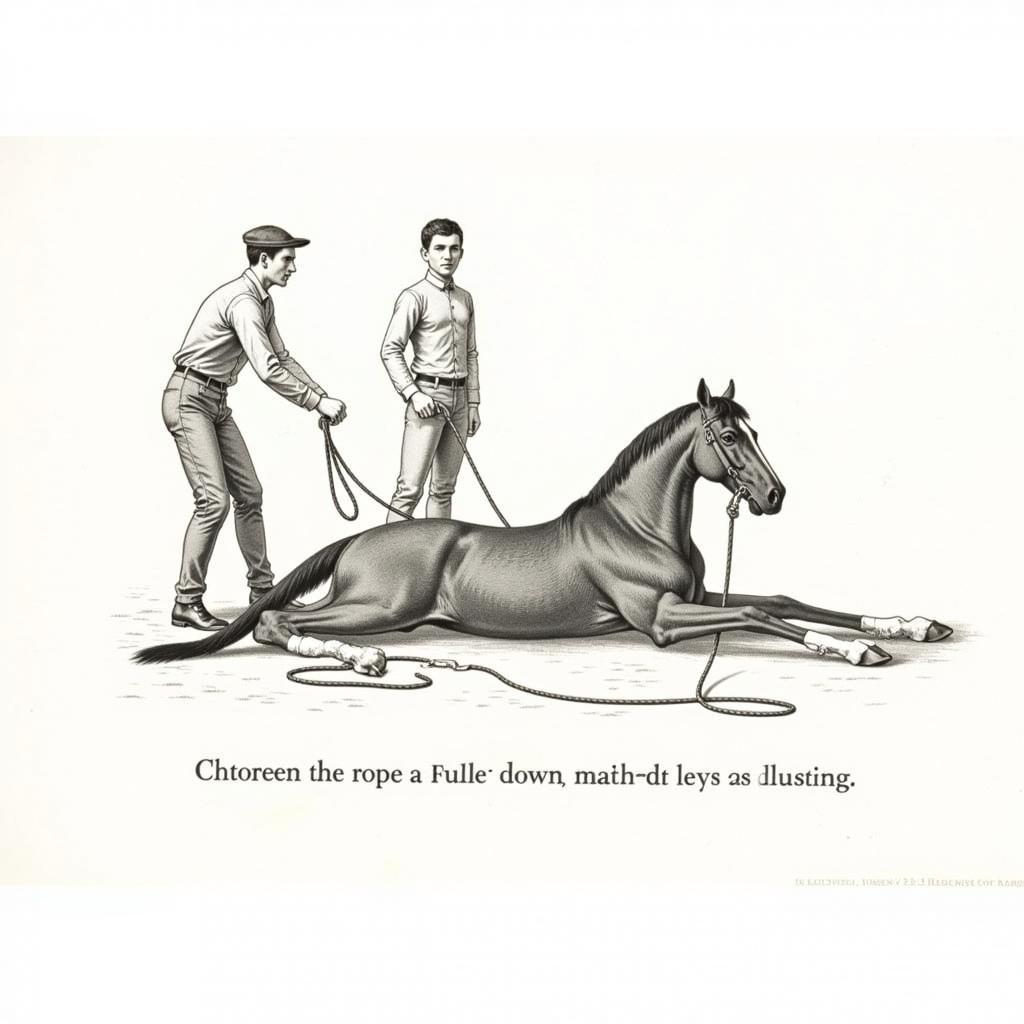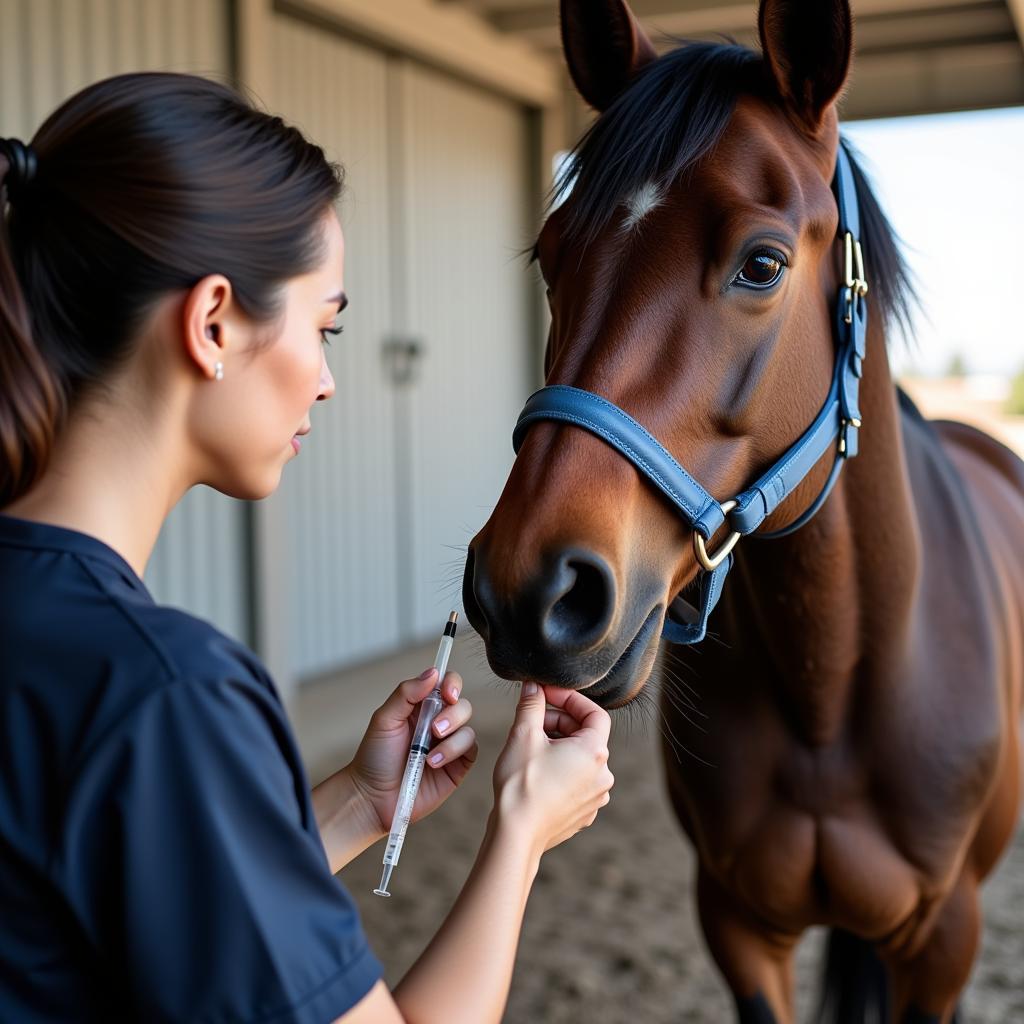Laying a horse down is a practice that sparks curiosity and raises questions. While it might seem like a simple act, it involves understanding equine behavior, trust, and potential risks. This article explores the different methods used for Laying Horses Down, the reasons why someone might do it, and the important considerations for safety and animal welfare.
Why Would You Lay a Horse Down?
There are a few reasons why someone might want to lay a horse down. These range from medical necessities to training techniques. Historically, laying a horse down was sometimes used in training, particularly in certain disciplines. However, modern horsemanship generally favors less coercive methods.
- Medical Procedures: In veterinary medicine, laying a horse down can be necessary for certain procedures such as surgery, dental work, or treating injuries. In these cases, the horse’s safety and well-being are paramount, and the procedure is performed by trained professionals under controlled conditions with appropriate sedation or anesthesia.
- Training (Historical Context): In the past, laying a horse down was occasionally employed as a method of asserting dominance or demonstrating control. This practice is now widely considered outdated and potentially harmful.
- Emergency Situations: In some emergency situations, like a horse trapped or injured, knowing how to safely lay a horse down can be crucial for its survival.
How to Lay a Horse Down: Methods and Safety
It’s crucial to understand that laying a horse down should never be attempted without proper training and expertise. Improper techniques can cause injury to both the horse and the handler. The most common method employed by veterinarians involves a system of ropes and gentle, controlled pressure.
The Rope Method
This technique requires specialized knowledge and multiple experienced handlers. It involves strategically placing ropes around the horse’s legs and body, then slowly and carefully applying pressure to encourage the horse to lie down. This should only be performed by trained professionals.
Chemical Restraint
In most veterinary procedures where a horse needs to be laid down, chemical restraint is used. Sedatives and anesthetics are administered by a veterinarian to ensure the horse’s comfort and safety during the procedure.
 Horse Laying Down Using Rope Method
Horse Laying Down Using Rope Method
Is Laying a Horse Down Ever Necessary?
While historically used in training, laying a horse down is rarely necessary outside of medical or emergency situations. Modern training methods focus on building a relationship of trust and respect between horse and handler through positive reinforcement and clear communication. Dominance-based methods are generally discouraged. For the majority of horse owners and enthusiasts, understanding the why behind laying a horse down is far more valuable than the how.
Safe Handling Practices
Working with horses requires respect for their size and power. Always prioritize safety by:
- Building trust and rapport.
- Approaching horses calmly and confidently.
- Seeking professional guidance when needed.
- Using appropriate equipment.
 Horse Being Sedated by Vet
Horse Being Sedated by Vet
Conclusion
Laying horses down is a complex topic involving a blend of historical practice, modern veterinary medicine, and emergency procedures. While understanding the methods is important, prioritizing the horse’s well-being and seeking professional guidance are essential. Remember, building a strong, trust-based relationship with your horse is the foundation of safe and effective horsemanship.
FAQ
- Can I lay a horse down myself? No, it’s highly recommended against laying a horse down without professional training and assistance.
- Why is laying a horse down no longer common in training? Modern horsemanship emphasizes positive reinforcement and less coercive methods.
- Is it safe to lay a horse down? Only when performed by trained professionals in controlled environments, like veterinary clinics.
- What should I do in a horse emergency? Contact a veterinarian immediately and follow their instructions.
- Are there alternatives to laying a horse down for medical procedures? Depending on the procedure, some treatments can be done with the horse standing. Consult your veterinarian.
- What are some resources for learning more about safe horse handling? Local equine veterinarians, experienced trainers, and reputable online resources can offer valuable information.
- What are mud control mats for horses? Check out our mud control mats for horses to learn more.
If you need further assistance, please contact us: Phone: 0772127271, Email: [email protected] or visit our address: QGM2+WX2, Vị Trung, Vị Thuỷ, Hậu Giang, Việt Nam. We have a 24/7 customer service team. You may also enjoy browsing our herd your horses cards selection or learning about slinkys for horses. If you’re interested in games, try the hold it horses crossword. For information on equine health concerns, read our article on a collapse of horses.